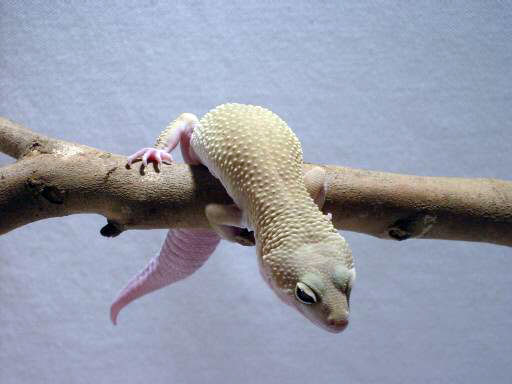
Leopard geckos are found in south-Asian Afghanistan, north-west India, & parts of Iran.
Since these animals are nocturnal, they spend their days hidden under rocks or in burrows to keep out of the daytime heat, and come out at dusk to hunt insects. In the wild, they are very social and live in large colonies.
------------------------------------------------------------------------------------------------
Subspecies & Color Varieties
There are 5 subspecies:
- Eublepharis macularius macularius
- Eublepharis macularius afghanicus
- Eublepharis macularius fasciolatus
- Eublepharis macularius montanus
- Eublepharis macularius smithi
There are 4 naturally occurring variations:
- Normal: A "normal" leopard gecko is usually an orange-yellow with dark spots.
- High Yellow: A "normal" leopard gecko with high yellow pigment and reduced dark spots.
- Pastel: The black pigment is replaced with pale tan, so essentially there is no black at all. Usually have extremely pale coloration.
- Jungle: Pattern of broken stripes, usually going all the way to the tail.
Normal
High Yellow
Pastel
Jungle
------------------------------------------------------------------------------------------------
General Information
Size & Life Span
A leopard gecko grows to be about 8 inches (120 cm) long, and will weigh anywhere from 50-120 grams. Its average life span is Up to 20 years.
*
Environment
A leopard gecko's natural environment is dry, rocky grassland and desert. In the winter, the temperature in these regions can get very low, so the leopard geckos are forced to go underground into a semi-hibernation and live off fat reserves.
*
Unique Facts
- Unlike most geckos, leopard geckos have eyelids.
- They are one of the only types of geckos that do not climb, and they do not have sticky toe pads.
- Pakistan is the only country that allows the export of leopard geckos to the U.S. Nearly all of the leopard geckos in the U.S. are captive-bred.
- Leopard geckos are neither threatened or endangered.
*
Reproduction
Leopard geckos reach sexual maturity between eight to nine months of age. Typically, they will breed from January to August or September as single pairs or in groups of one male and several females. A female may need to interact with and get to know a male before she chooses him as her mate. During breeding, a male will tap his tale, which signals that he is ready to mate. Females can store sperm for the course of their breeding season, so a male is only needed for one copulation. A female will lay 6 to 8 clutches, which consists of 2 eggs in each clutch, so approximately 12 to 16 young. The gestation period for a leopard gecko is about 30 days.
------------------------------------------------------------------------------------------------
Care in Captivity
Cage Size: A 10-20 gallon aquarium can house one or two leopard geckos from hatchling to adult size. Some people use plastic storage boxes as housing. What ever enclosure is used, it should be at least one foot high. It should have a secure screen top that can hold a light fixture.
-
Lighting, Temperature, and Humidity: A simple spotlight with the appropriate wattage bulb can provide daytime light and heat. In the day, the temperature should be around 90 degrees F directly under the spotlight, and at night it can go down into the low 70s. Since under the spotlight is in the 90s, that will allow the rest of the cage to be in the 80s. It's recommended to provide a temperature gradient and let the gecko regulate its own temperature. Humidity chambers are required for the gecko to properly shed its skin. If the gecko does not have one, skin can build up around the toes and eyes and become infected. A little moist cave with moss in it would do, since the moss holds moisture and wouldn't have to be sprayed as much.
-
Substrates: Paper towels are the most recommended substrate because they carry no risk of ingestion, they can just be replaced when soiled, and they are absorbent and hygenic. Newspaper and indoor/outdoor reptile carpet are also good options because they are easy to replace and clean, and there is no risk of ingestion. Sand, wood shavings, corn cob, and gravel are substrates to ALWAYS AVOID because the gecko could easily ingest them.
-
Feeding: Since leopard geckos are insectivores, crickets should be the staple part of their diet. Super worms, meal worms, wax worms, and pinkies can be given occasionally, to provide variety. The average adult will eat 3-5 crickets every day, but juveniles should be fed however much they will eat twice a day since their metabolisms are faster when they are younger. Supplementation is important; the food can be dusted with calcium and vitamins twice a week for adults, and once a day for babies.
-
Special Needs: Leopard geckos need a hiding area. There should be one per gecko in every cage. It should consist of a small box where the gecko can go to sleep and conceal himself, curved pieces of bark, and live or artificial plants, so the gecko can feel secure and hidden.
-------------------------------------------------------------------------------------------------
Notice the eyelids, which most other geckos do not have.
This is what a healthy leopard gecko's tail should look like. It should be round and fat.
Leopard geckos' feet do not have sticky toe pads, instead they have tiny claws.




